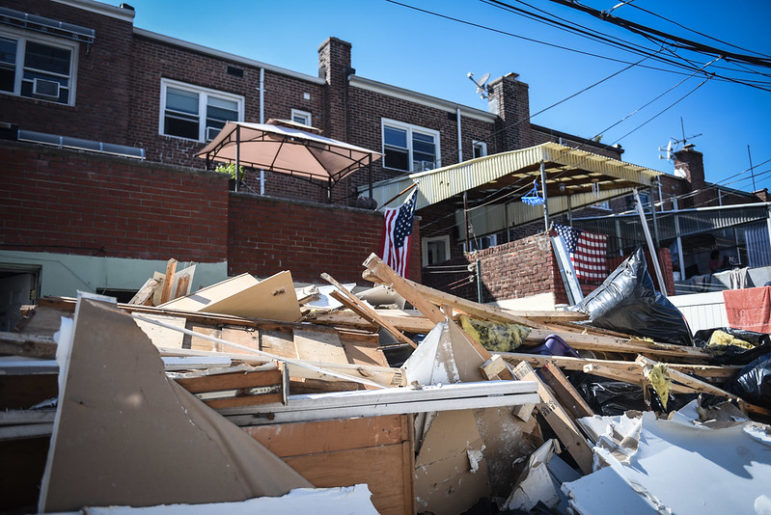So far, 85 undocumented applicants have been approved to receive the city and state joint relief assistance funds; another 33,000 survivors have been approved for FEMA’s Individual Assistance Program as of Nov. 21.

Michael Appleton/Mayoral Photography Office
Ida aftermath in Queens.Lea la versión en español aquí.
Editor’s note: After this story was published, Gov. Kathy Hochul announced that the state is extending the deadline to apply for the Ida Relief Fund through Jan. 4. More information can be found here.
On the first night of September, the remnants of Hurricane Ida flooded the city’s streets, basements, and subways, taking the lives of 13 New Yorkers. Tenants in sub- or at-grade spaces bore the brunt of the flooding, disproportionately affecting low-income and immigrant communities across the city, though concentrated in the outer boroughs.
On Sept. 26, New York Gov. Kathy Hochul and Mayor Bill de Blasio announced the creation of a relief program for the estimated 5,100 undocumented immigrants who were affected by Ida. But as of Nov. 24, only 32 applicants have received the aid; another 53 have been approved and are pending payment, the governor’s office reports. The fund is slated to close to new applicants on Monday.
The $27 million relief program was created for undocumented New York State residents or families who do not have U.S.-born children, and therefore did not qualify for aid from the Federal Emergency Management Agency (FEMA). The New York State Office for New Americans (ONA) oversees the program, and eight community-based organizations (CBOs) are in charge of both the application process and distributing the funds.
To estimate the impact of the storm on the residences of undocumented immigrants, the Mayor’s Office of Immigrant Affairs (MOIA) “used the number of undocumented-only households in the City at large as a starting place, since undocumented-only households are ineligible for FEMA relief. Based on data from the New York City Office of Emergency Management and CBO partners, we estimate that 5,100 individuals have been affected by Hurricane Ida and are ineligible for FEMA relief,” said MOIA via email.
To apply for the aid, immigrants can visit the participating CBO locations directly and submit an application to be eligible for up to $72,000 in grants in two categories: $36,000 for housing assistance and up to $36,000 for additional funds. ONA encouraged applicants to call their hotline (at 1-800-566-7636) to receive guidance on the documentation needed. So far, ONA reports 1,615 people have called into the hotline or walked into the organizations to apply.
There were 352 initial applications, while 474 households “have been deemed eligible for FEMA and referred accordingly,” wrote the governor’s office.
The fund has dispersed $146,469 to the 32 eligible households so far, and $191,399 has been approved—although pending payment—to another 53 applicants. Much of the aid, $144,009 of it, has gone to alleviating what the program considers to be “other needs assistance” expenses, which covers things like vehicle damage, moving costs, childcare and other aid that’s separate from direct housing needs.
ONA’s hotline is not tracking the most-used languages among applicants nor the zip codes they’re applying from, but based on what CBOs have reported, Spanish and Chinese are the most common. According to NBC News, nearly all of the storm’s basement deaths were among Asian residents.
Both FEMA and ONA, however, are tracking applications by county and both agencies say most are coming from Queens, where 55.6 of the undocumented population is Hispanic and 29.8 percent is Asian, per the Center for Migration Studies.
In total, 85 undocumented applicants have been approved to receive the city and state joint relief assistance funds, while 33,000 New Yorkers have been approved for FEMA’s individual assistance program as of Nov. 21. And there could be thousands more, FEMA explains, since the agency has received more than 80,000 valid registrations.
“Although our records show more than 21,000 cases have not been approved for assistance, this number may vary once survivors submit the necessary documents on appeal,” wrote a FEMA spokesperson.
The payments have totaled more than $157.2 million in approved assistance to New Yorkers through FEMA as of Nov. 21, and another $337,868 has been approved to help undocumented survivors as of Nov. 24.
The destruction from Ida prompted calls for the city and state to better fortify its storm protection measures; Ida’s destruction was largely caused by intense rainfall and flash floods that overwhelmed the city’s sewer systems, a departure from the coastal flooding seen during earlier extreme weather events, like Hurricane Sandy.
It also brought renewed attention to the plight of tenants in basement apartments across the city, many of which are illegal conversions rented by low-income residents, often immigrants. While New Yorkers can consult stormwater flood maps showing the likelihood of flooding on a block-by-block level, there is no easy way to check the flood history of a particular building, allowing prospective renters or buyers to determine the risk.
On Nov. 5, the mayor released “The New Normal: Combatting Storm-Related Extreme Weather in New York City,” a report that aims to help the city “prepare for and respond to extreme weather,” according to a press release. But there isn’t much information for undocumented residents, though the report acknowledges how Ida disproportionately impacted low-income and immigrant communities.
If not extended, both FEMA’s and ONA’s programs are set to close to applicants on Dec. 6, although applications submitted up to this day will continue to be processed by caseworkers, and payments will continue to be made beyond this date.
When asked if the program would be extended, the governor’s office only said that they are working to determine the ability to extend the program beyond its deadline.










One thought on “Two Months After Ida, Only 32 Undocumented New Yorkers Have Received Storm Damage Relief Funds”
Ceo Renee Mitchell Of Breaking The Cycle Drop Corp. And Co Chair of the policy committee of National Coalition of Homeless. Says there shouldn’t be a time frame on helping those in need the policy should be change when its a disaster at hand. And they should be oversite to keep track that the resources the one may be apply for is process correctly. We half to stop putting a band aid on issue people want result. A nuff with the talk now let start with action.